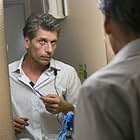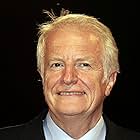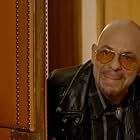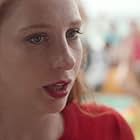In January 1920, Paul Deschanel, a French politician little-known to the general public, unexpectedly won the presidential election against Georges Clemenceau, leader of the Council of Minis... Read allIn January 1920, Paul Deschanel, a French politician little-known to the general public, unexpectedly won the presidential election against Georges Clemenceau, leader of the Council of Ministers. Deschanel (Le Président) was an eccentric person and a political idealist who wanted... Read allIn January 1920, Paul Deschanel, a French politician little-known to the general public, unexpectedly won the presidential election against Georges Clemenceau, leader of the Council of Ministers. Deschanel (Le Président) was an eccentric person and a political idealist who wanted to transform his country. Clemenceau (Le Tigre) was considered to have led France to vict... Read all
Photos
- Alexandre Millerand
- (as Christian Hecq sociétaire de la Comédie Française)
Storyline
Did you know
- TriviaFrench visa # 148349 delivered on 16-8-2022.
- SoundtracksI'm Always Chasing Rainbows
Lyrics by Joseph McCarthy
Music by Henry Carroll
Adapted from "Fantaisie Impromptu" composed by Frédéric Chopin
(1947)
Why on earth have we no trouble remembering historical figures when they are evil, monstrous, destructive? How come our memories refuse to erase the names of Hitler, Stalin, Pol Pot, Pinochet and the like? Why on the contrary are our minds reluctant to print those of persons who did good, who were ahead of their time, who helped humanity to progress? Shouldn't positive figures be more entitled to prominence than the sowers of hatred, death and destruction? But that's the way things are and under these conditions it is commendable that historians, writers or filmmakers (as is the case here with Jean-Marc Peyrefitte) periodically bring to light a few of these forgotten ones of history.
« The Tiger » of the title is - it goes without saying - Georges Clémenceau. Whose name is definitely not forgotten - and for good reasons. True, he was not always a good person (he could prove pushy, haughty, bossy, callous, offensive), but he was nevertheless driven by humanist, progressive ideas, at least in the first part of his career. On the other hand who on earth, apart from historians, can say anything serious about Paul Deschanel, « The President »? Worse, to the few who still recollect him, Deschanel is nothing better than that ridiculous short-lived president who, one night, affected by madness, fell from the official train. The only common image remaining of him is accordingly that of a poor wretched fellow, dressed in pajamas, wandering in the dark countryside, along the railroad tracks... Of course there is more to Deschanel than just that. Didn't he, for one thing, manage to be elected (and by an overwhelming majority) against such an illustrious figure as the « Tiger », Georges Clémenceau, the very architect of the 1918 victory? And before that, to be elected and re-elected as a deputy, as well as twice as the President of the Chamber of Deputies? Did the other deputies really deliberately chose a clown at each vote?
Certainly not. The so-said mental defective was actually an erudite man, with an unusual gift for eloquence, as well as a fine politician and strategist. And more than just that, the man professed new ideas, ahead of his time in more than one field: decentralization, agricultural unionism, workers' unionism, cooperatives, mutuality, income tax, social laws, political reforms, solidarity, women's vote. He was also against death penalty (which was only put into effect in France in 1981) - incidentally a common point with Clémenceau.
Revealing to the public the man's true colors is clearly the main objective that presided over the making of this film. Mission accomplished if only partly insofar as Peyrefitte has, in turn, simplified things. But how could it be otherwise with only two hours of projection time available? In any case, simplification is not oversimplification and Deschanel eventually comes out of it grown (and for posterity hopefully). Presented as a visionary, the President now looms large while his neurasthenia (largely mocked and amplified by his enemies) elicits compassion rather than derision. In his shoes, Jacques Gamblin, although not physically resembling his model, delivers a magnificent performance, restoring all the subtleties of the character, torn at the time of his presidency between brilliant political intelligence and unquenchable anguish. The "madness" of the character particularly suits him, giving the actor the opportunity to indulge in unexpected antics, at the same time outlandish and poetic. Opposite him, André Dussollier visibly enjoys himself capturing Clémenceau's idisosynchrasies, from his physical characteristics (massive body, drooping mustache) to his mental ones (his « old lion » incredible energy, his propensity to show his claws, his biting outbursts). The film is also worthwhile for its meticulous description of the Third Republic's rusty machinery. A rusty system operated by slackers clinging to their power An idealistic reformer like Deschanel who wanted to make things happen on his own could only crash against it and break.
As for the direction, it is rather undistinguished on the whole, but however deserves some praise: three good point make it an altogether satisfactory screening experience : a fine period reconstruction, two great actors and an imaginative illustration of Deschanel's delirium. They are enough to make "The Tiger and the President" worth seeing.
And a positive figure put in the spotlight rather than a bloodthirsty monster, it is not to be refused.
- guy-bellinger
- Apr 11, 2023
- Permalink
- How long is The Tiger and the President?Powered by Alexa
Details
- Release date
- Countries of origin
- Language
- Also known as
- The Vanished President
- Filming locations
- Palais de l'Elysée, Rue du Faubourg Saint-Honoré, Paris, France(exteriurs of the Palis de l'Elysée)
- Production companies
- See more company credits at IMDbPro
Box office
- Gross worldwide
- $1,162,077
- Runtime1 hour 38 minutes
- Color
- Aspect ratio
- 2.35 : 1
Contribute to this page











